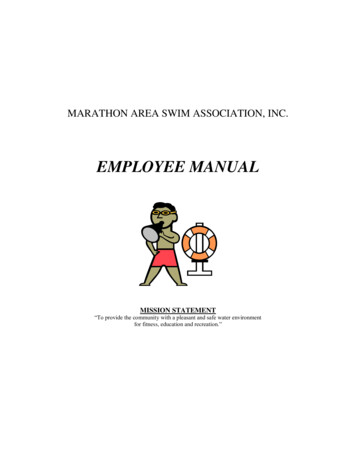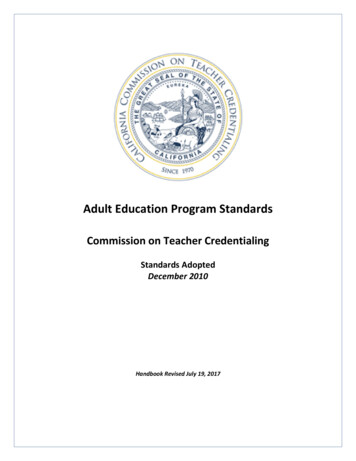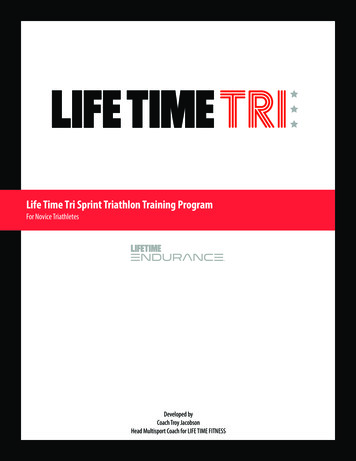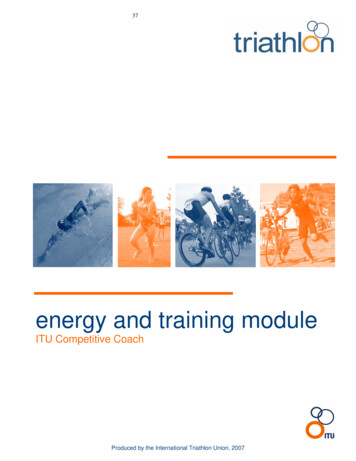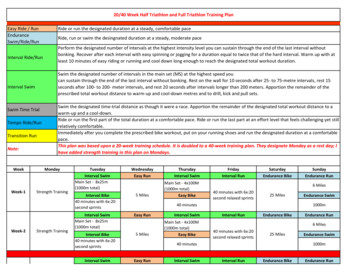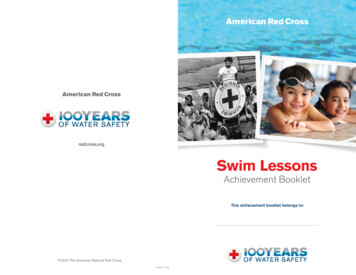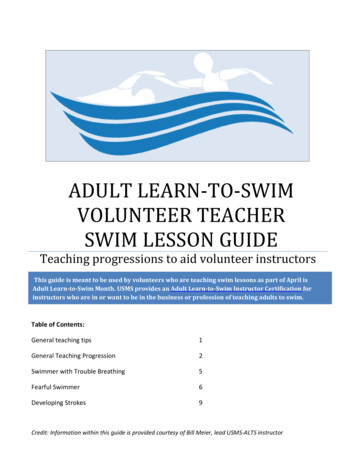
Transcription
ADULT LEARN-TO-SWIMVOLUNTEER TEACHERSWIM LESSON GUIDETeaching progressions to aid volunteer instructorsThis guide is meant to be used by volunteers who are teaching swim lessons as part of April isAdult Learn-to-Swim Month. USMS provides an Adult Learn-to-Swim Instructor Certification forinstructors who are in or want to be in the business or profession of teaching adults to swim.Table of Contents:General teaching tips1General Teaching Progression2Swimmer with Trouble Breathing5Fearful Swimmer6Developing Strokes9Credit: Information within this guide is provided courtesy of Bill Meier, lead USMS-ALTS instructor
Giving Back to the Activity We LoveAs a Masters swimmer, sometimes it’s hard to believe that there are adults who have troubleswimming. The spectrum of people you will meet as an instructor ranges from those who are sofearful they do not want to approach the water to people who want tips on improving their butterfly.As a volunteer dedicated to helping people gain confidence and a degree of proficiency in the water,you are giving a gift that will forever affect your student’s lives in a positive way. Enjoy the experience!Adults who are interested in swim lessons generally fit into four categories – the non-swimmer who isnot afraid, the swimmer needing stroke improvement, the swimmer with trouble breathing and thefearful nonswimmer. Each of these categories has a set of different requirements and usually requiresa different approach from the instructor. When deciding to help teach swim lessons, consider the typeof person you want to work with, how patient you can be, and if you want to teach the basics or thefiner points of stroke development.In the Beginning Before going near the water, develop trust with your student by simply talking with them about theirexperience around the water and what they would like to accomplish in the lessons. Many adults whowant to take lessons have issues around the fact that they have put this off for so long. Discuss thiswith them and reassure them that it’s never too late to learn this essential skill.Some Teaching Tips:1. You must have patience and empathy for the adult student. You will not help the student if youget frustrated that they are not learning or progressing at your pace. You are there to help andguide the student.2. To facilitate learning, every student should be encouraged to wear goggles.3. When helping a nonswimmer, you should get in the water to demonstrate the skills you teach.4. For swimmers wanting to improve their strokes, standing on deck while instructing will give youthe best vantage to see all elements of the stroke.5. Use the sandwich method of criticism! Tell the student what they did correctly before and aftera criticism.6. People learn a skill predominantly in one of three different styles – listening, seeing or bypracticing (kinesthetically). Teach each new skill by explaining, demonstrating, explaining againand then practicing so that you address each style.1
I) GENERAL TEACHING PROGRESSION – Many adult swimmers will come to a lesson with somedegree of experience and comfort in the water, so whether your student is a nonswimmer who is notfearful or they can do rudimentary strokes (dog paddle), start them from the beginning to assure thatthey have proficiency in the foundational skills.Most of the steps here can be done with little or no physical contact with your students. Not only doesthis empower the student quickly so they are willing to advance through the steps faster, it alsoalleviates any personal space issues. After your student has demonstrated capability of a given skill,move immediately to the next, progressing at your student’s speed.1. Bobs –Initially, check to see if the student can blow bubbles on the surface and if they arecomfortable putting their face in the water. If they cannot do these, then practice with the explanationthat the foundation of good swimming is effective air exchange. Explain that when swimming, youcan breathe out through your mouth or nose, but must always breathe in through your mouth.Practice on the surface until they are comfortable. Proceed to doing bobs. This exercise isolates theskill of breathing without having to worry about staying afloat:While standing on the bottom and holding on the side with both hands, your student will bend at theknees and submerge their head completely. They should blow out through their mouth and then standup to take a breath through their mouth. This should be done at least ten times at the beginning ofeach lesson.Watch for explosive bubbles when the student is underwater. A trickle of air will not empty thelungs efficiently.Listen when the student’s head comes out of the water. You should only here an inhalation. If there isany exhalation, remind the student to blow ALL air into the water and only breathe in when the face isexposed to the air.Sometimes, students get water in their nose. If this happens, remind the student to only blow outthrough their nose and breathe in through the mouth. In extreme cases, recommend nose plugs. Nonose pinching allowed because you can’t do this and swim at the same time.2. Front Float – Explain to the student that when they take a deep breath, their lungs are filled with airand act as floatation. While holding the side, the student should back away from the wall until they areleaning into it diagonally with their arms straight. Tell them to take a big breath and put their face in soonly the back of their head is exposed. Have them hold that position until they need to take a breath.Count out loud each time so the student knows the limits of their breath. If relaxed, this is when manypeople will begin to float. If they do not float, tell the student to push their chest into the water andstart kicking gently. This will generally help those who are not as buoyant as others. In the first fewattempts, as the student floats, tell them to lift their head after no more than 5 seconds so they don’tbreathe in while the face is submerged. Practice holding the breath for longer periods and point out if2
the person lifts their head, their feet will sink. As they float at the side, have them relax their grip onthe side and bounce their hands over the wall to get a sense of their buoyancy.Watch that the student’s head is in line with their spine AND if the student begins to float away fromthe wall, gently grab their wrist and guide them back.3. Standing Up – Once your student is floating, explain that to get vertical in the water, push downwith both hands while simultaneously lifting the head and bringing the knees to the chest. Practice thisinitially using the wall for leverage. Once this is mastered, practice floating away from the wall. Initially,your student should try to stand as soon as their feet leave the bottom so they have enough air torecover if the attempt is not perfect.Watch that the student raises both knees at once. Sometimes, when first trying this, the student willextend one leg behind them and bring only one leg under.4. Back Float – Explain that one of the most important skills a person can master in the water is theability to float on their back. While doing a back float, a person can see where they are, breathenaturally and call for help if needed.To start, have your student hold the wall in chest deep water. Their chest, hips, and knees should beresting on the wall as they hold on at water level with elbows bent. Ask your student to bend theirknees, lifting the feet from the bottom. They should relax and let the water support them – this willusually happen with their shoulders just below the surface. Once comfortable and aware of theirbuoyancy, instruct your student to lift their chin to the ceiling as they let their shoulders drift awayfrom the wall, straightening the elbows. Watch that your student keeps their knees and hips close tothe wall so their back is arched. At this point, you can put your finger between your student’s shoulderblades and remind them you will not let their face go under water. Have your student stay in thisposition until they are completely relaxed and barely using the wall for support. When you see thatthey are floating, ask them to let go of the wall as they take a full breath. Stay with them as they beginto float, instructing them to push away from the wall gently with the tops of their feet. Help themstand and then practice more.Remind them – Head Back, Belly Up! If your student lifts their head and drops their hips, this is anattempt to get into the fetal position, an instinctive response to a fear inducing situation!To stand – Just like with the front float, lift the head, bring the knees to the chest and scull with thehands at the same time.5. Front Glide – Explain the ready position – hold the gutter with one hand, two feet on the wall, otherarm pointing down the lane. To glide, take a breath, put the face in the water and release the wallplacing the fingers of one hand over the fingers of the other.Remind - Elbows straight, and biceps pinch the ears.3
6. Back Glide – The student should hold the gutter with their feet on the side in a crouch position – thebasic backstroke start position. They should look to the ceiling with their ears in the water. Their armsshould be straight and relaxed. Tell them to release the side as they lift their hips to the surface andstraighten out. The push off should be gentle and slow with the ears remaining submerged.Remind – Head Back, Belly Up! Hands to the side “at attention like a soldier.”7. Flutter Kick* – Have the student hold the wall again and practice kicking. Explain that the kickshould be fast, even and small (feet spreading no more than 1 foot). When kicking, the knees shouldbe straight but loose and the ankles should be “floppy” like your trying to shake off a loose shoe. Thestudent should feel the kick in their hamstrings and quads. Have the student add this to their glideimmediately.Watch for feet coming out of the water too high on front kick and knees coming out of the water onthe back. Correct both of these by reminding to keep the knees straight but loose.If fins are available, these can aid greatly in developing a good kick.*Some adults do not have the ankle flexibility required for a functional flutter kick. For a percentage ofadults, the breaststroke kick is the best alternative when the flutter kick does not produce forwardmomentum.8. Freestyle without breathing – Show your student the freestyle arm stroke while you stand andexplain – reach the arms long in front, bring the hands down the side of your body, stretch the armslong toward the thigh, recover with high elbow. Keep both arms moving. To start, have the personpush off the wall in a glide, begin kicking as soon as the feet are off the wall and then start the stroke.Give helpful corrections after each attempt but avoid giving more than one or two points at a time.Remember the “sandwich method” of criticism.Remind - The three basic elements of freestyle without breathing – arms long in front and back, headdown and fast kick.9. Freestyle with breathing – For many people, this is where they stopped swim lessons as children.Incorporating breathing can be a hurdle, but one many adults are excited to conquer. Repeat thefollowing progression as often is needed for your student to master this skill.Bobs –Do at least 10 of these again to reinforce the importance of breath control.Single-arm stroke at the wall – Decide with the student which side they will breathe to whenswimming freestyle, then instruct to hold the wall with the opposite hand. Explain that whilestroking, when the hand is up (brushing the wall), they should breathe out with their face in thewater. When their arm is down (by their side), they should breathe by looking to the ceiling andkeeping their ear in the water. Repeat this and correct for proper rhythm and head position.4
Freestyle with one breath – Starting from the end of the lane, have the student swim freestylewithout breathing to see how far they can go. After walking back to the wall to catch theirbreath, tell the student to do the same thing, but start blowing out air as soon as they startstroking. When they need to take a breath, wait for their hand to come to the side, turn theirhead to look at the ceiling and take a breath. Give helpful suggestions and repeat any of theabove steps to reinforce necessary skills. Increase breaths and distance as the student getsgood air exchange.Watch for bubbles on either side of the neck as the student is swimming and note the student’shead position when they take a breath. They should look at the ceiling to clear water from theirmouth on initial attempts, but they should not look forward.Listen for if the student actually takes a breath.II) THE SWIMMER WITH TROUBLE BREATHING - One of the most common complaints fromadult students is that they can swim, but they run out of breath and get tired by the time they finish alap of the pool. Breath control is the foundation of good swimming. Without the ability to get rid ofcarbon dioxide and fill the lungs with oxygen-laden air, muscle fatigue will make it impossible tocontinue without stopping.1. Watch the student swim. Ask the student to swim a length of the pool swimming freestyle. As theyswim:a. Watch for bubbles on the sides of the head and neck.b. Watch their head movement as they take a breath – do they lift the head out of the water?c. Listen when their head turns – do you hear an exhalation when they should be inhaling?2. Watch their reaction. Once the swimmer gets to the other side, watch if it is hard for them to catchtheir breath. If so, wait for them to settle down before offering advice.a. Explain you’d like them to swim another length.b. Tell them that their stroke, kick and body position are fine, and they should not thinkabout those at all.c. Explain that the only thing they should concentrate on is blowing their air into the water andwhen they turn their head, inhale through the mouth.Oftentimes, simply telling your student to concentrate on blowing all their air into the water beforeinhaling to the side can dramatically improve the person’s comfort level in the water. Whenswimming, many people focus on the arm and leg movement and whether they keep themselvesafloat. By simply telling your student to concentrate on clearing their lungs, they will be focusing on theskill they need to improve.5
Use this progression if more remedial help is needed:1. Blowing bubbles – Start the lesson by explaining that for the student to swim for any distance,they must be able to breathe naturally. Have the student hold the side of the pool with two handsfacing the wall. Leaning toward the wall, they should purse their lips and blow bubbles on top of thewater. Lift the head to get a breath. Explain that once they get their face in the water, the studentshould initially only breathe through their mouth – water up the nose can slow this process andcan be avoided with mouth breathing. When this has been mastered, your student shouldprogressively put their nose, eyes and whole face in the water while blowing out.2. Bobs – Bending at the knees, your student should submerge their head completely, blow out throughtheir mouth and stand to take a breath. For more breathing options, the student should be encouragedto try blowing out through their nose also.3. Single-arm stroke at the wall – Decide with the student which side they will breathe whenswimming freestyle, then instruct to hold the wall with the opposite hand. Explain that while stroking,when the hand is up (brushing the wall), they should breathe out with their face in the water. Whentheir arm is down (by their side), they should breathe by looking to the ceiling and keeping their ear inthe water. Repeat this and correct for proper rhythm and head position.4. Freestyle with one breath – Starting from the end of the lane, have the student swim freestylewithout breathing to see how far they can go. After walking back to the wall to catch their breath, tellthe student to do the same thing, but start blowing out as soon as they start stroking. When they needto take a breath, wait for their hand to come to the side, turn their head to look at the ceiling and takea breath. Watch for bubbles on either side of the neck as the student is swimming and LISTEN if thestudent actually takes a breath. This skill can take some time to perfect. Go back to one arm stroke atthe wall to practice proper positioning and timing if necessary. Increase breaths as the student getsgood air exchange.II) THE FEARFUL SWIMMER – Many adults have had a traumatic experience that left them with afear of water. The degree of fear is dependent on the incident and the person’s reaction to it. The mostimportant thing to remember when teaching someone in this situation is to go at the person’s paceand be sensitive to how they feel throughout your time with them. They should always feelcomfortable and in control. For the instructor, this takes a great deal of patience. Be ready to sit andtalk with this student for much of the first class. It is essential that the student does not feel rushed.Your empathy will earn you their trust!6
It is unlikely that a fearful swimmer will overcome their fear of water and be to a point of comfort toattempt the Red Cross five basic water competencies in a few lessons. If you as a volunteer are not ableto make the time commitment or you are uncomfortable with the patience required to teach a fearfuladult, please refer them to a provider who specializes in this field.If you choose to help a fearful adult, each time your student comes to the pool you will want torepeat the following steps from the beginning. Repetition builds confidence.1. Pre-class conversation – Before going near the water, it is very important to talk with your studentabout their feelings about the water and their goals for taking lessons with you. Try to avoid detaileddescriptions from them about the reason for their fear, and, instead, try to get them to focus on thefuture – how has the fear affected their life and how would they like to change this? If your studentwants to discuss the exact incident, let them, but do not encourage reliving what happened. This cansometimes be counterproductive to the goals you are both setting. Most importantly, they should feelthat you hear them and know that you want to help. People who are fearful can react in a variety ofways including near-paralysis around water on one end of the spectrum to a willingness to immediatelyget in the water on the other. Whatever your student’s reaction to the pool, be prepared to spend a lotof time discussing how they feel about the water. Remember, fear is a primal emotion and can be quitedifficult to overcome – Don’t Rush!2. Move to the water – When ready, invite your student to sit by the edge of the pool. Encourage themto put their feet in the water and remember to ask repeatedly how they are doing, if they feel safe, orif they’d like to back up. Watch your student’s response to having contact with the water. Gauge yournext move based on your student’s comfort level. Let the student sit in this position for as long as theywant and point out how pleasant the water feels, to think about what it is and not what it could do.3. Test the water – If the student can maintain their composure with their feet in the water, invitethem to touch the water with their hands and gently swirl the water. This is a huge undertaking forsome people. Imagine being afraid of heights and standing next to a cliff – you don’t rationallyconsider that you’re safe on solid ground, you see yourself falling over the edge. Someone who isfearful of water is touching the source of their fear and knows irrationally that they could drown in thenext minute! WATCH the person’s reaction. Do they cringe or hesitate? Do they look in control? Try toget them to comment on the actual sensation – cold, warm. Sit with them in that position until theyare ready for the next challenge.4. Getting in – Compliment the student on their effort and courage! Ask if they’re ready to enter thepool and stand on the bottom. If not, relax while sitting on the side. If so, explain the depth of the7
water and where it will come up on them. Continue that they are going to keep their feet on thebottom and that they will hold the side with both hands. If ready, carefully enter the water using theladder. Stay next to the ladder as the student climbs down. Remember, the student is facing a majorfear, so let them go at their own pace. Sometimes, physical touch can help this process – a hand on ahand or on the person’s shoulder. Explain that they are safe, with both hands holding the side, theirfeet firmly on the bottom, you standing next to them, and the lifeguard and others on deck watchingas backup. Remind them that they can stop and return to the deck at any time.5. Getting acclimated – Once in, encourage the student to hold on the side with two hands. Watchtheir reaction and ask how they feel. At this point, the student should start moving so they don’t getcold. Have the person walk back and forth along the wall for a few feet. Talk to them about thesensations of being in the water, of standing on the bottom – get them to focus on the present andkeep complimenting them on getting this far. As always, watch the student’s reaction – are theyrelaxed? Do they have a far-away gaze or are they talking and engaged? Again, ask if they would like tocontinue or get out.6. Head In – If your student appears ready to move on, explain that getting the face and head in thewater is an important element of developing comfort. Explain that you are going help them movetoward that – progressively and slowly.Chin First – Have the student hold on to the side with their feet firmly set on the bottom of the pool. Have thestudent lower their chin into the water and then lift it out. If relaxed, let the student hold their chin under for longerperiods of time. If you count out loud, the student will have an exact gauge of how they are progressing. Rememberto compliment the whole time! Repeat this until the student feels a degree of mastery. Go back to walking along theside again.Bottom Lip and Blowing Bubbles – If the student wants to continue, have them put their lower lip in the water. Theirmouth should be closed as they hold their breath. Once again, repeat for longer duration while you count. Whenrelaxed, have the student gently blow bubbles on the surface. Do not let them breathe in until they lift their facefrom the water. In preparation for the final goal of this step, the student should be told that once their face getswet, they should breathe through their mouth to avoid getting water in their nose.Nose, Eyes and Ears – These are all openings where water can get “in” and for many fearful adults, getting these inthe water is a major hurdle. After practicing blowing bubbles, invite the student to put the bottom of their nose inthe water while they hold their breath. Count for them so they can gauge their proficiency. Once the student iscomfortable going this far, invite them to close their eyes and quickly put their face in the water. You can count forthem as they keep their face in the water for longer periods.While going through this progression, it is recommended to ask if the student would like you to put yourhand over theirs as they hold the side. It is often reassuring to the student to have some physical contactwith you, especially when they have their eyes closed.8
When the student is comfortable placing their face in the water, have the student back away from the wallso that their arms are straight. While bending at the hip, the student should lean into the water so their faceand ears go under the water’s surface.Once again - For any of the above drills that include breath holding, count for the student out loud andchallenge them to repeat for longer on each attempt. If the student gets nervous in any way, back up to aplace that is safe. Walking along the edge is a stand-by for refocusing.7. Floating – Explain to the student that when they take a deep breath, their lungs are filled with airand act as floatation. Many fearful swimmers never consider this and are glad for this information.While holding the side, the student should back away from the wall until they are leaning into itdiagonally with their arms straight. Tell them to take a big breath and put their face in so just the backof their head is exposed. Remind them to hold tight to the side. Have them hold that position whileyou count. At this point, many people will begin to float on their own. If they do not float, tell thestudent to push their chest into the water and start kicking gently. This will generally help those whoare not as buoyant as others. Do not let the student keep their head in for more than half their longestbreath hold. For fearful swimmers, floating is a HUGE hurdle that has seemed insurmountable for alifetime. The first float should be celebrated when it happens. IV)REMEMBER – At any time during this progression, remind your student that they can stop or goback to a more comfortable place.Although it seems hard to believe, you will probably only get as far as #5 if you offered fivelessons to a fearful adult.DEVELOPING STROKES – As a Masters Swimmer, you know that good strokes are the basisfor efficient, fast, and enjoyable swimming. Some students will come to get instruction on strokes theyalready have some proficiency in. The following gives helpful tips for the four competitive strokes:BUTTERFLY –Arms – Arms move simultaneously, reaching with straight elbows in front, pulling through the waterwith elbows bent down the middle of the body, finishing the pull with straight elbows and hands closeto the hips.Recovery – Thumbs down, elbows straight9
Body – Like a wave rolling from the head to the feet – When the hands enter, the hips come up!Head – Push chin on the water’s surface to get a breath. Drop head quickly to initiate body roll.Kick – Dolphin. Feet together, undulate from the hips, knees straight but loose.BACKSTROKE –Arms – Hand enters slightly outside the shoulder with straight elbow. With bent elbow, move handdown along the side and “rip” out along hip leading with the thumb.Recovery – Thumbs out, pinkies in - elbows straightBody – Flat in the water, rolling along the axis of the spine with each stroke.Head – The head is back, looking straight up and unmoving.Kick – Flutter kick being careful not to lead with the knees.BREASTSTROKE –Arms – This is a scull stroke. Sweep hands out, palms leading; Sweep hands in using a sculling motion.Recovery – Shoot hands forward leading with fingertips.Body – A wave initiated as the arms lunge forward on the recovery.Head – The head can either remain still diagonally pointed forward or moving enough to emphasizethe body roll.Kick – “The Frog Kick.” With knees bent heels to buns, point toes toward the wall and kick back,down and around finally squeezing legs together.Timing – For the beginner - Kick-Stretch-Pull. As the swimmer gets more comfortable - Pull-Kick-GlideFREESTYLE –Arms – Hands enter above shoulder with straight elbow. With bent elbow, move hand along the sideof the body and exit slightly above thigh.Recovery – Elbow bent and high, hands close to the water and close to the bodyBody – Flat in the water, rolling along the axis of the spine with each stroke.Head – Head is neutral, looking below the swimmer.Kick – Rhythmic flutter kick keeping the feet no more than 12 inches apart. Knees straight but loose.10
swimming. The spectrum of people you will meet as an instructor ranges from those who are so fearful they do not want to approach the water to people who want tips on improving their butterfly. As a volunteer dedicated to helpin


